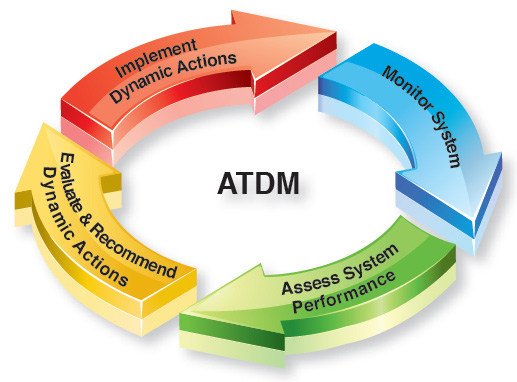The Active Transportation and Demand Management Program (ATDM): Lessons Learned
Executive Summary
In response to the growing pressure for agencies to do more with less and address congestion challenges from all aspects of the network, the Federal Highway Administration (FHWA) is working to promote a dynamic approach to manage the transportation network. The approach seeks to optimize performance and increase efficiency throughout the entire trip chain as seen from the traveler’s perspective. Termed Active Transportation and Demand Management (ATDM), the program advances the ability to manage, control, and influence travel demand, traffic demand, and traffic flow of transportation facilities.
The program builds off the existing investments that state and local agencies have made in transportation systems management and operations. Investments on our transportation facilities are wide-ranging and include monitoring systems (detectors), communication backbones, advisory systems (message signs, highway advisory radios), field personnel and vehicles (safety service patrols), centers (traffic management centers), public information portals (websites, 511), control systems (traffic signal systems, ramp meters, road/lane closure systems), and operational information exchanges (Computer Aided Dispatch [CAD] integration, data warehousing). Leveraging these investments to realize a greater degree of real-time, dynamic management and operational capability is the primary goal of the program.
Figure ES-1 illustrates the continuous dynamic nature of ATDM when applied to system management and operations. Under an ATDM approach, the transportation system performance is continuously assessed; dynamic actions using existing tools and assets are constantly evaluated and implemented in real time to achieve performance objectives, such as preventing or delaying breakdown conditions, improving safety, promoting sustainable travel modes, reducing emissions, or maximizing system efficiency. Implemented actions are continuously monitored as they start to affect system performance. This cyclical approach can be carried out at various operational time-scales, ranging from longer-term strategic approaches to the short-term tactical decisions.

Source: FHWA
- Active Traffic Management: A suite of strategies that actively manage traffic on a facility. Examples include variable speed limits, dynamic shoulder use, queue warning and lane control strategies.
- Active Demand Management: A suite of strategies intended to reduce or redistribute travel demand to alternate modes or routes. Examples include comparative multi-modal travel times, dynamic ride-sharing, pricing and incentive approaches.
- Active Parking Management: A suite of strategies designed to affect the demand, distribution, availability, and management of parking. Examples include dynamic parking pricing, real-time parking availability and reservation systems.
All agencies and entities operating transportation systems can advance toward a more active management philosophy by making changes that move operations along the active management continuum. This progression on the continuum represents a natural evolution in an agency’s ability to provide and the public’s acceptance of active management as shown in Figure ES-2.

Sources for figures: (left – Battelle, middle – Washington DOT, right – UK Highways Agency
Through a series of outreach workshops across the country, transportation professionals have learned about the concept of ATDM and had the opportunity to question early implementers of various approaches about specific issues and discuss the lessons they learned along the way to implementation. Peers across the country consistently challenged implementing agencies to answer questions regarding ATDM and their approach to implementation. These questions spanned the breadth of planning, design, and operations issues facing agencies and point to the recurring challenges agencies face when considering new approaches to managing congestion in their jurisdictions. Common themes that resonate with transportation professionals include agency approaches to incorporating ATDM in the planning process, regulatory and institutional obstacles that may need to be overcome prior to implementation, the importance of developing strong partnerships with stakeholders, the importance of outreach, addressing design exceptions created by ATDM applications, appropriate signage to adequately convey operational strategies to travelers, and operations and maintenance approaches and responsibilities.
In general, ATDM requires that agencies increase their emphasis on customers, who will want to know how they can directly benefit from ATDM. Agencies need to understand that customers are more than highway users and that they need to be seen as an ally and advocate for ATDM. Providing real-time, accurate communications can help gain them as allies. It is also important to identify and demonstrate successful institutional arrangements for ATDM. Another key approach is to show customers what they gain from ATDM rather than focusing on how the agency benefits. The use of polls and focus groups can help agencies understand the public’s perspectives and help them to develop messages.
Technological capability is core to ATDM but it is also important for agencies to recognize that technology is not the end-all for managing the transportation system. They do not need to be on the cutting edge to manage their system efficiently. The fact that technologies change so rapidly could result in the public sector chasing technologies instead of maximizing what they have. The goal of agencies needs to be to maintain and/or operate their equipment to its fullest potential. Technology can enhance management and operations, but it is not a panacea or the necessary end- result.
Policies and regulations can present challenges to the deployment of ATDM approaches, which push the boundaries of operations, partnerships, and opportunities. Ensuring that laws are flexible enough to accommodate them and the myriad ways they are planned, developed, financed, and implemented helps move the state of the practice forward.
Effective communications is also essential to implementing ATDM on a broad basis. If an agency cannot convince the public that innovative approaches can help solve their problems, then it cannot hope to gain the attention of policymakers and decision makers. Members of the public can be critical partners, advocates, and champions. Consistent messages from all levels of the organization help sell the concept, especially when they resonate with the greater population and target issues that are of global concern, such as health and safety. How a message is crafted can make or break a project and a program.
previous | next